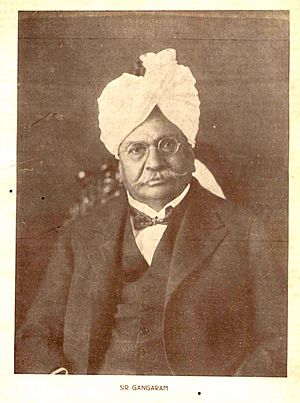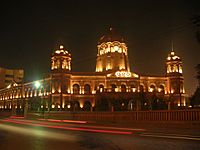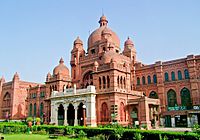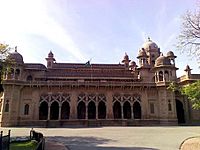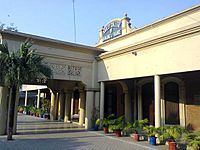Ganga Ram facts for kids
Quick facts for kids
Rai Bahadur Sir
Ganga Ram Agarwal
|
|
|---|---|
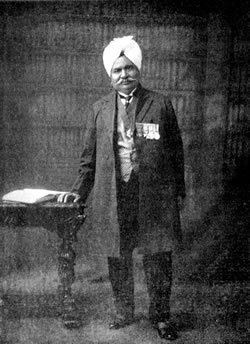 |
|
| Born |
Ganga Ram Agarwal
13 April 1851 |
| Died | 10 July 1927 (aged 76) |
| Resting place | Portion of remains scattered in Ganges while the rest are stored in the Samadhi of Sir Ganga Ram in Lahore |
| Monuments | Samadhi of Sir Ganga Ram near Taxali Gate, Lahore |
| Other names | "Father of Modern Lahore" |
| Education | Government High School |
| Alma mater | GCU Lahore Thomas college |
| Occupation | Civil engineer |
| Known for | General Post Office, Lahore Lahore Museum Aitchison College, Lahore Mayo School of Arts Sir Ganga Ram Hospital Mayo Hospital, Lahore Sir Ganga Ram High School Hailey College of Commerce The Mall, Lahore |
| Relatives | Ashwin Ram Shreela Flather Kesha Ram |
Rai Bahadur Sir Ganga Ram CIE MVO was a famous Indian civil engineer and architect. He was born Ganga Ram Agarwal on April 13, 1851, and passed away on July 10, 1927. He made huge contributions to the city of Lahore. At that time, Lahore was part of colonial India, which was ruled by the British. Today, Lahore is in Pakistan. Because of his amazing work, people called him "the father of modern Lahore."
Contents
Early Life and Education
Ganga Ram Agarwal was born on April 13, 1851. His birthplace was a village called Mangtanwala in the Sheikhupura District. This area was part of the Punjab Province in British India. Today, it is in Punjab, Pakistan. His family was a Punjabi Hindu Baniya family from the Agarwal community.
His father, Doulat Ram Agarwal, worked as a junior police officer in Mangtanwala. Later, his family moved to Amritsar. There, his father became a copy-writer for the court. Ganga Ram finished his high school exams at the Government High School in Amritsar. In 1869, he started studying at the Government College in Lahore.
In 1871, Ganga Ram received a special scholarship. This allowed him to study at the Thomason Civil Engineering College in Roorkee. He was a brilliant student. In 1873, he passed his final engineering exam with a gold medal. After finishing his studies, he became an assistant engineer. He was called to Delhi to help build the Imperial Assemblage. This was a big event held by the British rulers.
Career as an Engineer
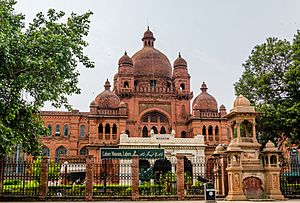
After working for a short time in the Punjab Public Works Department in 1873, Ganga Ram decided to try farming. He leased about 50,000 acres of dry, empty land from the government. This land was in the Montgomery District. In just three years, he changed this huge desert into green fields. He did this by building a hydroelectric plant to lift water. He also created a thousand miles of irrigation channels. He paid for all of this himself. This was the biggest private farming project of its kind in the country. Sir Ganga Ram earned a lot of money from this project. He gave most of it away to help others.
Sir Malcolm Hailey, who was the Governor of Punjab, once said about him: "He won like a hero and gave like a Saint." This shows that Ganga Ram was both a great engineer and a very generous person.
In 1900, Lord Curzon, a high-ranking British official, chose Ganga Ram for an important job. He was asked to be the superintendent of works for the Imperial Durbar of 1903. This event celebrated King Edward VII becoming king. Ganga Ram successfully managed all the challenges of this huge project. He retired early from his service in 1903.
He received the special title of Rai Bahadur in 1903. On June 26, 1903, he was also made a Companion of the Order of the Indian Empire (CIE). These honors were for his excellent work at the Delhi Durbar. On December 12, 1911, he received another honor. He was appointed a Member of the Royal Victorian Order (MVO). In 1922, he was made a Knight. This meant he could use "Sir" before his name. King-Emperor George V personally gave him this honor at Buckingham Palace on July 8.
Sir Ganga Ram designed and built many important buildings in Lahore. These include the General Post Office, Lahore, the Lahore Museum, and Aitchison College. He also built the Mayo School of Arts, which is now the National College of Arts. Other buildings he designed are the Ganga Ram Hospital (built in 1921), Lady Mclagan Girls High School, and the chemistry department of the Government College University. He also worked on the Albert Victor wing of Mayo Hospital and the Sir Ganga Ram High School (now Lahore College for Women). The Hailey College of Commerce (now Hailey College of Banking & Finance), the Ravi Road House for the Disabled, and the Ganga Ram Trust Building on "The Mall" were also his projects. He also built the Lady Maynard Industrial School.
Beyond buildings, he created Model Town and Gulberg town. These were once the best places to live in Lahore. He also built the powerhouse at Renala Khurd. He even helped build the railway track between Pathankot and Amritsar. After India and Pakistan became separate countries, a new hospital was built in his memory. This was the Sir Ganga Ram Hospital in New Delhi, built in 1951.
Work in Patiala State
After he retired, Sir Ganga Ram became the Superintending Engineer in Patiala State. He worked on a big project to rebuild the capital city. Some of his works there included the Moti Bagh Palace, the Secretariat Building, New Delhi, Victoria Girls School, the law courts, and the police station.
In a place called Tehsil Jaranwala, near Lyallpur (now Faisalabad), Ganga Ram built a very special way to travel. It was called the Ghoda Train, which means "horse-pulled train." This was a railway line that went from Buchiana Railway station to the village of Gangapur. It was a simple track with two small trolleys. Instead of a train engine, a horse pulled the trolleys. This unique train was used for many decades, even after India and Pakistan became independent. It stopped working in the 1980s because it needed repairs. In 2010, the Faisalabad District Authorities brought it back. They made it a cultural heritage site.
Agricultural Achievements
Sir Ganga Ram was also a very good farmer. He leased over 20,000 acres of land from the government near Renala. This land was dry and barren. He used his engineering skills to completely irrigate it with hydro-electric pumps. This turned the dry land into fertile fields. He also bought thousands of acres of empty land in Lyallpur. By using modern irrigation methods, he made these lands productive.
He created an award called the Maynard-Ganga Ram award. It came with Rs 3000 and a special fund of Rs 25000. This award was given every three years. It was for anyone who found new ways to increase farm production in Punjab.
Death and Legacy
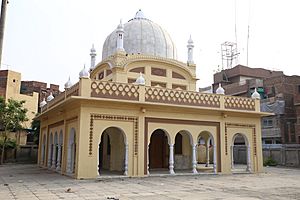
Sir Ganga Ram passed away in London on July 10, 1927. His body was cremated, and his ashes were brought back to India. Some of his ashes were scattered in the Ganges River. The rest were buried in Lahore, near the Ravi River. A special memorial, called a samadhi, was built for him in Lahore.
A marble statue of Sir Ganga Ram once stood in a public square in Lahore. The famous writer Saadat Hasan Manto wrote a story about it. During the riots in 1947, some people were trying to erase the memory of Hindus in Lahore. A mob attacked Sir Ganga Ram's statue. They threw stones at it and covered its face with tar. Then, a man tried to put a garland of old shoes around its neck. The police arrived and shot at the crowd. The man with the shoes was hurt. As he fell, the mob shouted, "Let's take him to Sir Ganga Ram Hospital!" This was ironic because they were trying to destroy the memory of the very person who had built the hospital that could save his life.
Today, a student hostel called Ganga Bhawan was built in his honor. It is at IIT Roorkee, which used to be the Thomason College of Civil Engineering. The Sir Ganga Ram Hospital in Lahore, Pakistan, was partly damaged in a blast in 2009.
His family members, including his sons and daughters, now live all over the world. His great-grandson, Indu Vira, is the son of Dharma Vira, who founded the Sir Ganga Ram Hospital in New Delhi. Another great-grandson, Dr. Ashwin Ram, is a professor at the Georgia Institute of Technology. His great-granddaughter, Shreela Flather, Baroness Flather, is a teacher and a British politician.
Works
- Some buildings designed and built by Ram
Named After Ram
Institutes
- Sir Ganga Ram Hospital (India)
- Sir Ganga Ram Hospital (Pakistan)
Places
- Gangapur, Punjab, Pakistan
- Sir Ganga Ram's home, Punjab, Pakistan


